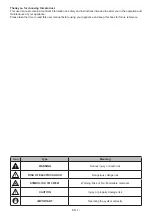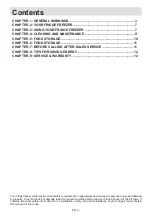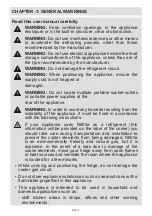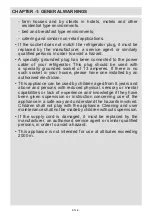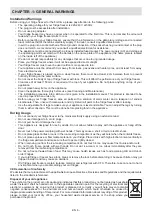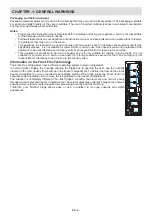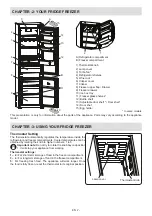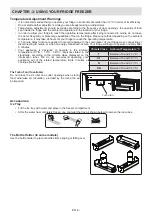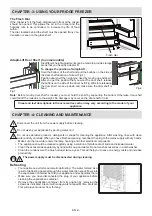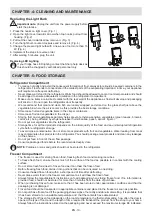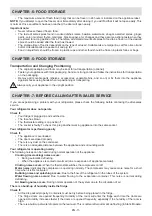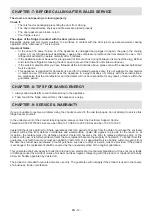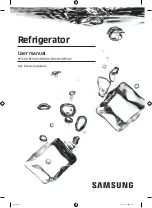
EN -10-
CHAPTER -4: CLEANING AND MAINTENANCE
Replacing the Light Bulb
Important note:
Unplug the unit from the power supply before
start the process.
1. Press the hooks on light cover. (Fig. 1)
2. Open the light cover towards arrow when top hooks pull out from
housing. (Fig. 2)
3. Pull out the cover towards arrow remove it. (Fig. 3)
4. Turn the light bulb counter clockwise and remove it. (Fig. 4)
5. Change the present light bulb with a new one of not more than 15
W. (Fig. 4)
6. Implement the steps in reverse order.
7. After waiting 5 minutes, plug the unit.
Replacing LED Lighting
If your fridge has LED lighting contact the Sharp help desk as
this should be changed by authorized personnel only.
1
2
3
4
CHAPTER -5: FOOD STORAGE
Refrigerator Compartment
• To reduce humidity and avoid the consequent formation of frost, always store liquids in sealed containers in the
refrigerator. Frost tends to concentrate in the coldest parts of the evaporating liquid and, in time, your appliance
will require more frequent defrosting.
• Never place warm food in the refrigerator. Warm food should be allowed to cool at room temperature and should
be arranged to ensure adequate air circulation in the refrigerator compartment.
• Make sure no items are in direct contact with the rear wall of the appliance as frost will develop and packaging
will stick to it. Do not open the refrigerator door frequently.
• We recommend that meat and clean fish are loosely wrapped and stored on the glass shelf just above the
vegetable bin where the air is cooler, as this provides the best storage conditions.
• Store loose fruit and vegetable items in the crisper containers.
• Store loose fruit and vegetables in the crisper.
• Storing fruit and vegetables separately helps prevent ethylene-sensitive vegetables (green leaves, broccoli,
carrot, etc.) being affected by ethylene-releaser fruits (banana, peach, apricot, fig etc.).
• Do not put wet vegetables into the refrigerator.
• Storage time for all food products depends on the initial quality of the food and an uninterrupted refrigeration
cycle before refrigerator storage.
• To avoid cross-contamination do not store meat products with fruit and vegetables. Water leaking from meat
may contaminate other products in the refrigerator. You should package meat products and clean any leakages
on the shelves.
• Do not put food in front of the air flow passage.
• Consume packaged foods before the recommended expiry date.
NOTE
: Potatoes, onions and garlic should not be stored in the refrigerator.
Freezer Compartment
• The freezer is used for storing frozen food, freezing fresh food, and making ice cubes.
• To freeze fresh food, ensure that as much of the surface of the food as possible is in contact with the cooling
surface.
• Do not store fresh food next to frozen food as it can thaw the frozen food.
• Before freezing fresh food, divide it into portions that can be consumed in one sitting.
• Consume thawed frozen food within a short period of time after defrosting
• Never place warm food in the freezer compartment as it will thaw the frozen food.
• Always follow the manufacturer's instructions on food packaging when storing frozen food. If no information is
provided food, should not be stored for more than 3 months from the date of purchase.
• When purchasing frozen food, make sure that it has been stored under appropriate conditions and that the
packaging is not damaged.
• Frozen food should be transported in appropriate containers and placed in the freezer as soon as possible.
• Do not purchase frozen food if the packaging shows signs of humidity and abnormal swelling. It is probable that
it has been stored at an unsuitable temperature and that the contents have deteriorated.
• The storage life of frozen food depends on the room temperature, the thermostat setting, how often the door is
opened, the type of food, and the length of time required to transport the product from the shop to your home.
Always follow the instructions printed on the packaging and never exceed the maximum storage life indicated.



